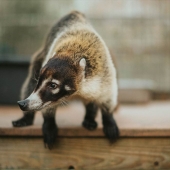COATIMUNDI
Class: Mammalia Order: Carnivora Family: Procyonidae Species: Nasua narica (White-Nosed Coati), Nasua nasua (Brown-nosed Coati) Status: Not threatened

Coatimundi (pronounced ko-WAH-ti-MUN-dee) are a member of the raccoon family, sharing the ringed tail and the inquisitive nature. However, the raccoon is nocturnal and the coatimundi is typically active during the day. The white-nosed coatimundi is a native of Central and South America, and can even be found in the desert areas of the American Southwest. The brown-nosed coatimundi lives only in South America.
LIFE SPAN
Normally 7-10 years in the wild, up to 17 years in captivity
DIET
Coatis are omnivores, eating both meat and plants. In the wild, they eat fruits, berries, insects, birds, eggs, lizards, and even snakes and small mammals like mice and squirrels. They use their long, probe-like nose for searching through leaves, crevices, and holes to find their favorite foods. The long claws on their feet are good for tearing apart rotting logs. The Catty Shack Ranch follows the USDA guidelines and feeds according to their body weight. They also follow strict nutrition requirements from their veterinarians and also add vitamins and minerals to all their food. We feed our coatis mostly chicken and sometimes beef, fruit like melons, oranges, and tangerines; and eggs. One special treat the coatis love is marshmallows!
SIZE
Coatis grow to a length of 20-24 inches, plus they have a tail that is another 24 inches long. They can weigh from 7-15 pounds.
HABITAT & NUMBERS
Coatimundi can inhabit almost any type of terrain from coastal mangrove forests to dense tropical forests, lowland savannas, and even deserts. They are plentiful throughout much of their range. They help control populations of mice and insect pests while serving as a source of food for larger predators, most notably big cats. Coatimundi live in groups of 5-20 or more females and their young. Males live generally solitary lives and are only allowed in the group for mating. This is to prevent males from eating the young. For the same reason, young male coatis are ejected from the group when they reach 2 years of age. Coatis are considered agricultural pests in some areas and have even been known to take poultry. They are also hunted for their meat. Survey’s of Nature currently estimates a total wild population of roughly 50,000 breeding animals.
REPRODUCTION
Coatis reach sexual maturity at about 2 years of age. Male coatis join the band of females during the breeding season, varying by location from October to March. After breeding, the females kick the males out of the group and prepare their nest, usually high in the trees. Gestation lasts for about 77 days and the mother produces 2-6 young. Coati young are blind for 12 days and stay in the nest until they are about 6 weeks old. They are weaned by the time they are 4 months old.
OTHER FUN COATIMUNDI FACTS
The coati’s tail can be longer than its head and body combined. It uses the tail for balance when climbing trees and to identify group members in tall grass on the ground.Their ankles are double jointed and extremely flexible. This enables the coati to descend a tree headfirst.
The legs and claws of a coati are strong enough to hold onto tree limbs with the back feet and eat with the front ones.
Coati have a quirky habit of dipping their noses in something with a flowery or perfumed aroma and rubbing it into their tails.
Coatis can growl, hiss, and bark when alarmed, but their normal communication is a high-pitched squeak.
The coatimundi is also called the hog-nosed coon, snookum bear and Brazilian aardvark.

